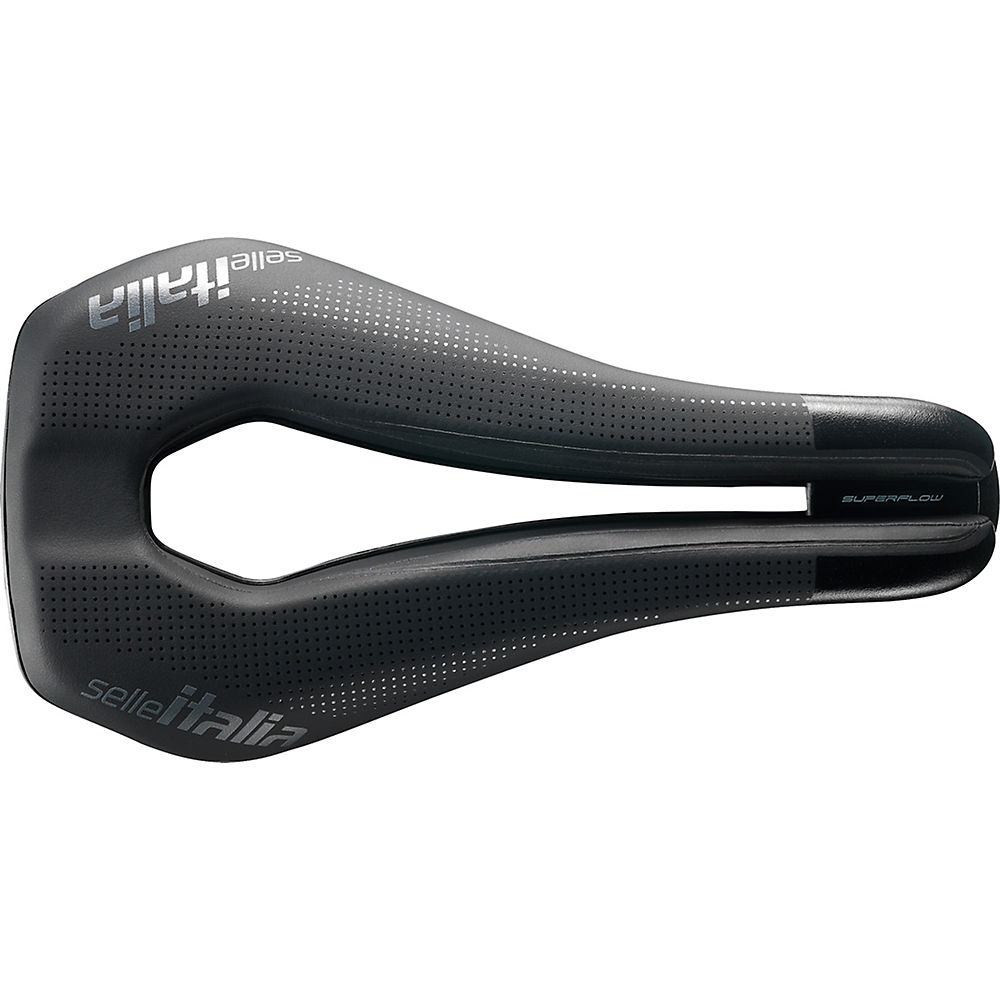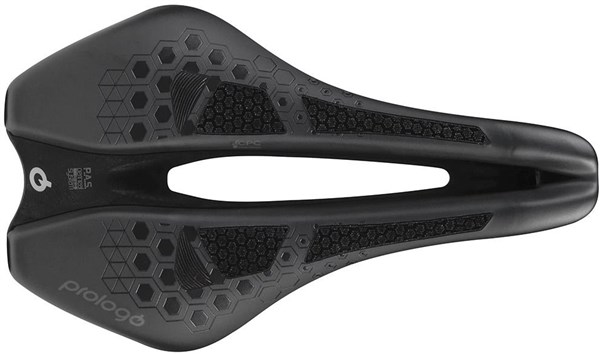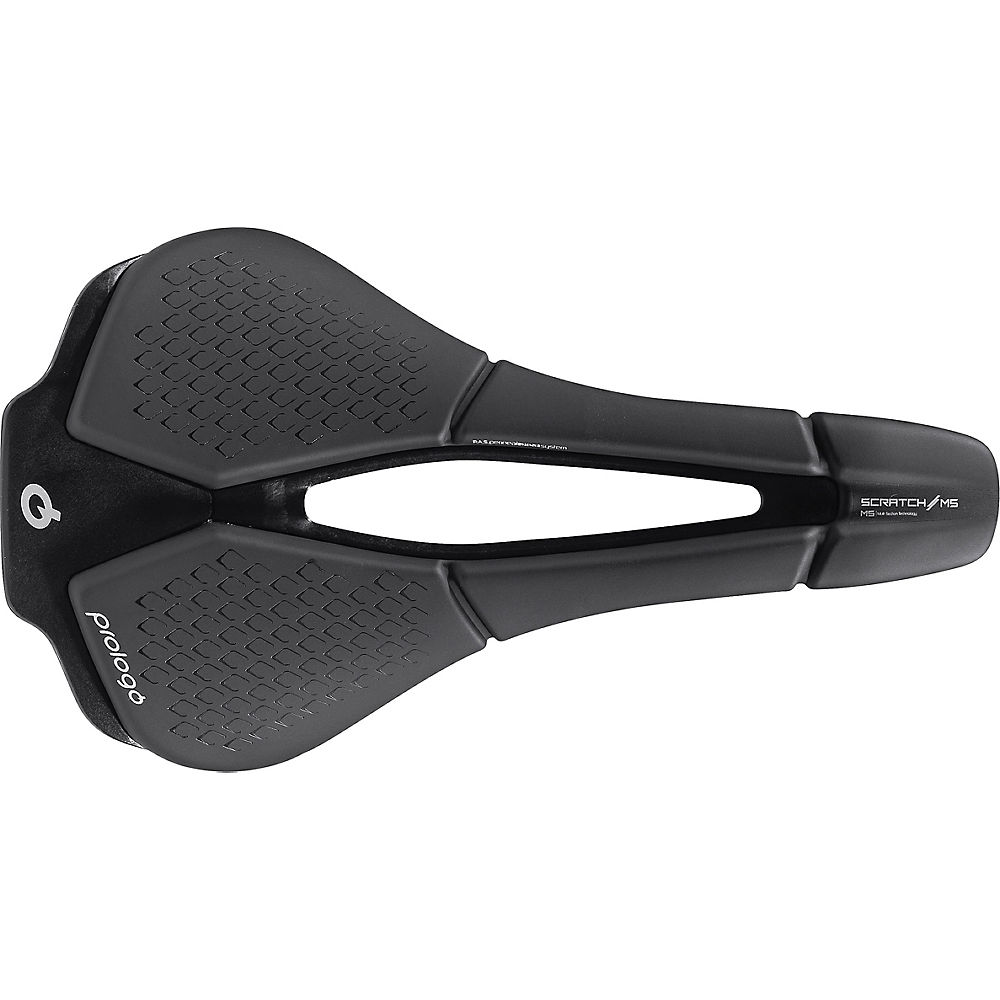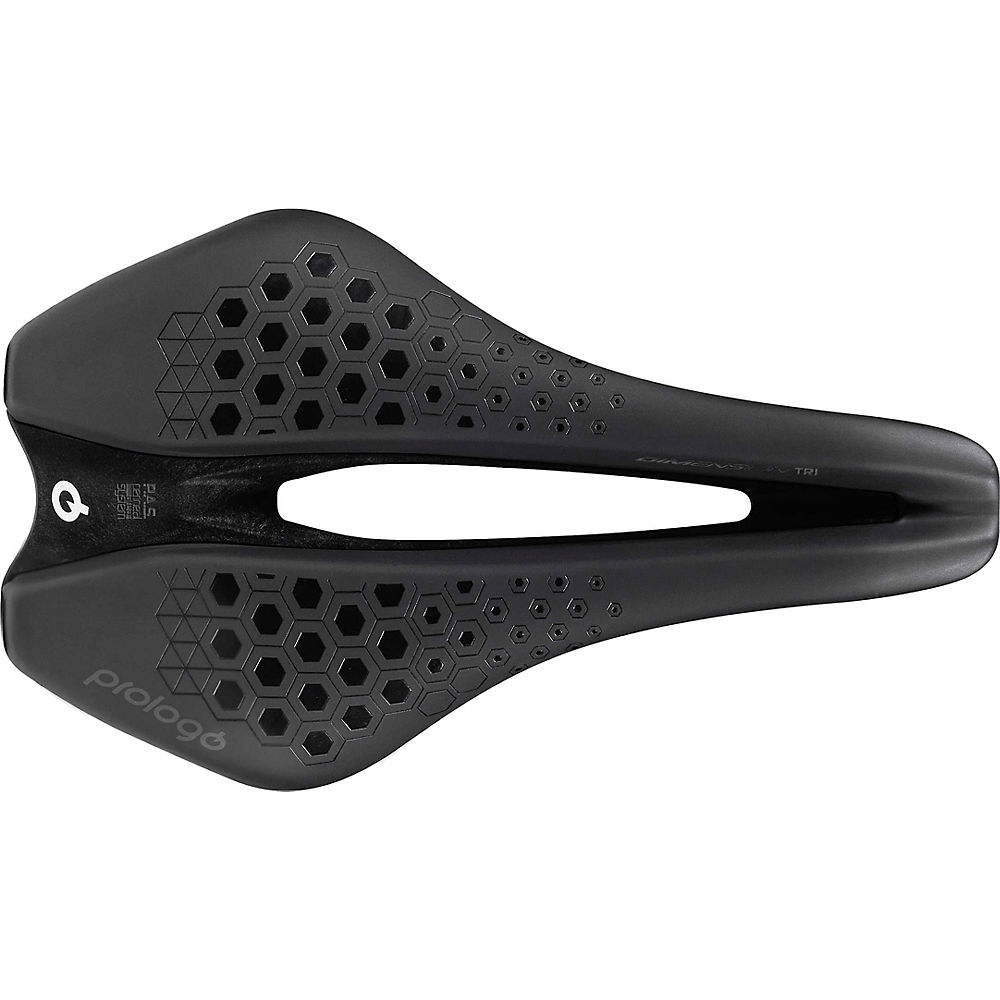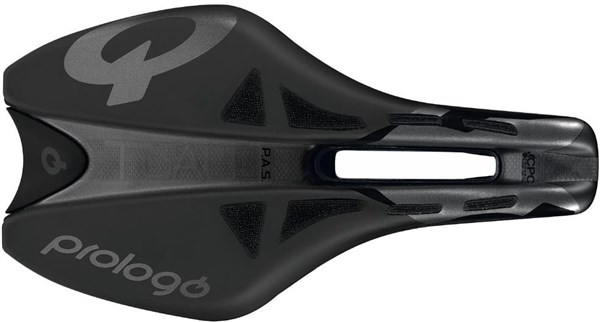Best triathlon bike saddles in 2025: 14 expert-tested options
Riding on your tri-bars often requires a different type of bike saddle, and there are plenty out there that are purpose built for tri. Jack Sexty rates some of the best triathlon saddles...

While you can spend vast amounts of cash upgrading your triathlon bike, a poor tri bike saddle choice negates the aero gains of wheels and bars if discomfort accompanies every pedal stroke. That’s why you must find a triathlon-specific cycling saddle that works for you.
Pain or numbness can, at best, leave you shuffling around on your saddle; at worst, you’ll get saddle sores and require recuperative time off the bike.
So it’s vital for both health and performance that you find a TT saddle that’ll allow you to hold a fixed position for long periods, especially if you’re an iron-distance triathlete.
Some bike shops offer a saddle-fitting service that includes measurement of your sit bones. This is well worth having to help you choose the right triathlon saddle – and we’d also suggest experimenting with different models. Ultimately, saddle choice is a personal thing.
Why you can trust 220 Triathlon
Our team of experts rigorously tests each product and provides honest, unbiased reviews to help you make informed decisions. For more details, see how we rate and test products.
Best triathlon bike saddles at a glance
The ISM PS 2.0 (buy) is incredibly comfortable for long hours in a TT position and perfect for triathlon.
While not triathlon-specific, the Fizik Vento Argo R5 (buy) works well on road and tri bikes.
The Fizik Transiro Aeris Long Distance R1 (buy) offers superb comfort for long tri distances.
The Prologo Dimension Tri Tirox 143 (buy) is light, comfortable and inexpensive.
Best bike saddles for triathlon in 2025
Best overall triathlon saddle

1. ISM PS 2.0
220 Triathlon verdict
One of ISM’s best tri-specific saddles yet also suitable for road bike Score: 90%
Pros
- Promotes stability
- Great comfort
- Reduces pressure
Cons
- None
| Price | $229.88 / £170 |
| Weight | 10oz/282g |
| Features | Chromoly rails, 130mm width, rear transition hook |
ISM’s noseless design is based on the company’s independent research, which tests their saddles against competitors to ensure maximum blood flow to reduce numbness down below.
The PS 2.0 – suitable for road or triathlon according to ISM – features an upward slope at the back, designed to provide extra hip support when rotated in the aero position or an aggressive road stance.
It means that those who tend to move around a lot in the saddle might struggle to fix themselves perfectly on it. Not me.
I found it hugely comfortable and it’s one of the few saddles I’ve tested that kept me completely fixed in the TT position for two hours or more without wanting to shuffle.

2. Selle Italia Watt Kit Carbonio Superflow
220 Triathlon verdict
As the price suggests, this is a luxury buy, but it does provide all-day comfort Score: 84%
Pros
- Very comfy
- Grippy cover
- Pressure relief
Cons
- Expensive
| Price | $279.90 / £239.90 |
| Weight | 7oz/198g |
| Rails | 10mm |
| Features | Wide cut-out, anti-slip cover |
The carbon-railed version of Selle Italia’s Watt Kit Carbonio Superflow was two-time Kona winner Patrick Lange’s seat of choice when we tested it.
It weighs 7oz/198g with a wide cut-out to provide pressure relief, and rails that are 10mm longer than its road saddles to ‘adapt the saddle to extreme aerodynamic positions’.
The nose (50mm wide at the tip), while considerably narrower than something like Fizik’s Mistica, is also long so you can find your ideal position.
The anti-slip cover has extra grips to hold you in place and the anatomically-shaped rear provides plenty of comfort.
Before buying, take advantage of Selle Italia’s ‘idmatch’, an online questionnaire that picks your ideal saddle based on stats like height, body type and racing goals.

3. Ergon SR Road Pro Men
220 Triathlon verdict
Intelligently designed for the different genders; worth trying before buying Score: 81%
Pros
- Lets you pedal freely
- Little pressure build-up
- Choice of widths
Cons
- Square cut-out intially felt unusual
| Price | $129.95 / £119.99 |
| Weight | 7.8oz/220g |
| Sizes | S/M, M/L |
| Features | Middle relief, narrow nose, male-focussed |
As Ergon’s Road Pro is aimed at road riding rather than triathlon, I whipped out the roadie for testing.
You might have also guessed it’s aimed at male riders, so to suit the narrower male sit bones and more upright pelvis, the cut-out is narrower and further back compared to the women’s.
It comes in S/M and M/L sizes, and I went for M/L to suit 14.5cm sit bones. It took some work to get the position spot on because of the very pronounced square central cut-out, but once in a groove we found it fine for long rides.
As promised, the narrow front gave our legs freedom to pedal, and I didn’t experience unwanted perennial pressure.
The Road Pro has some clever features, so if you suffer from numbness and are looking for a road/draft-legal tri saddle, go for it.
Best long distance tri saddle

4. Fizik Transiro Aeris Long Distance R1
220 Triathlon verdict
Simply one of the best triathlon saddles around right now. Score: 92%
Pros
- Superb comfort
- Carbon rails
- Bottle attachment included
Cons
- None
| Price | $209.99 /£189.99 |
| Weight | 7.1oz/202g |
| Features | Oversized carbon rails, rear bottle cage attachment |
This new tri-specific saddle from Fizik comes with a slimmer profile compared to its Mistica (reviewed below), and also makes use of a cut-out down the middle.
An impressive weight of 7oz/202g includes oversized carbon rails and the rear bottle cage attachment.
In my testing, the Aeris Long Distance R1 proved to be one of the most comfortable saddles, with zero soreness or numbness.
It’s profile also means it’s an ideal choice for anyone with a narrow pedalling stance, particularly if you ride aggressively.
The pressure relief is also top-notch, while the tacky cover helps keep you in place well.
Read our full Fizik Transiro Aeris Long Distance R1 review for more

5. Repente Magnet
220 Triathlon verdict
Expensive, specialist saddle for elites and top age-groupers Score: 79%
Pros
- Very light
- Carbon construction absorbs road buzz
Cons
- Quite firm
- Expenisve
| Price | $231.52 /£204 |
| Weight | 4.8oz/135g |
| Sizes | One size, 140mm width |
| Features | Carbon fibre |
This superlight saddle weighs just 4.8oz / 135g, with Repente deploying an advanced autoclaving technique to force the carbon to be more uniform and compact.
With carbon rails and a full carbon shell, the minimalistic build does naturally mean the Magnet is quite firm on first impressions, but the wide nose provides a comfy perch in the TT position.
It’s not the grippiest padding, so you’ll want to make sure it’s absolutely the right width for your sit bones to prevent unnecessary shuffling.
The thick carbon rails eat up road vibrations, which Repente says is in part due to the wider, flatter sections of rail at the back, designed to take most of the stress behind where you’re sitting when you’re clutching the tri-bars.
If you can deal with a firm saddle and want to shed weight off your bike, then Repente’s offering is well worth considering if you can budget for it.

6. Selle Italia Novus Boost Evo 3D Kit Carbonio Superflow
220 Triathlon verdict
Gloriously comfortable and tri specific, but incredibly expensive Score: 84%
Pros
- Wonderfully comfortable
- Triathlon-focused
- Vibration-damping rails
Cons
- Lavish cost
| Price | $429.90 / £365.99 |
| Weight | 7.8oz/222g |
| Sizes | One size |
| Features | Oversized carbon rails, central cut-out, 50mm nose |
Selle Italia’s Watt Kit Carbonio has enjoyed the 3D treatment, with the lattice-like structure acting as double-layered, lightweight padding.
Weighing 7.8oz/222g, it’s a little heavier than the standard version, but we’re promised better comfort and improved anti-slip to hold you in position.
Described as ‘the pinnacle of triathlon saddles’ and with a price tag to reflect that, I expected a lot – and I got it, finding things extremely comfortable on my test rides.
The 50mm nose is a great perch for riding in the TT position, but not too wide, so this saddle worked well on my road bike, too.
The ‘differentiated cushioning zones’ deliver support where you need it and firmness where you don’t, and the central cut-out relieves any hint of perineal pressure.
Oversized carbon rails dampen most vibrations to complete the luxury package, and if money’s no object it would top my wishlist for a dream tri-bike build.

7. ISM PS1.0
220 Triathlon verdict
A highly recommended saddle if you suffer with the dreaded numb-bum. Score: 90%
Pros
- Suits an aggressive position
- Keeps you stable
- Comfortable, supportive padding
Cons
- Wide wings may catch your legs
| Price | $239.88 / £230 |
| Weight | 8.9oz/253g |
| Sizes | One size, 130mm width |
| Features | Titanium rails, central cut-out, noseless |
ISM’s noseless design has titanium rails, weighs 8.9oz/253g and sits in their Performance Short category.
The PS1.0 is the brand’s recommendation for aggressive racers who want a fixed position, featuring firm padding and a slight slope at the front to support the hips in the TT position.
On the road we instantly hit it off, the ISM proving the best of the bunch at preventing excessive movement, while also being super comfortable.
The wide arms caught my sit bones a little when I came out of a tuck, so if you like to sit up or move a little then ISM’s Performance Narrow range might suit you better.
ISM saddles have solved the bottom woes of many a triathlete over the years, so they’re worth a punt if you can’t get on with more traditional-looking seats.
Best value triathlon saddle

8. Prologo Dimension Tri Nack 143
220 Triathlon verdict
An impressively light and versatile all-rounder that offers great value. Score: 86%
Pros
- Cut-out works well
- Good value
- Comfortable in different positions
Cons
- Narrow nose
| Price | $229 / £180 |
| Weight | 6.3oz/179g |
| Sizes | One size, 143mm width |
| Features | Tirox rails, central cut-out, noseless |
Prologo’s Dimension Tri weighed in at just 6.3oz/179g on my scales, and is designed for ‘comfort when on the drops and for aggressive riding’, suggesting road/ITU-style racing as well as long-course suitability.
In both the drops and on the tri-bars I found the Dimension Tri very comfortable on long rides. The 143mm wide shell and central cut-out provide a wide and pressure-relieving seat.
The nose is quite a lot narrower than the other stubby tri saddles on test. So it’s worth trying before buying if intended for middle or long-distance.
It’s almost $80/£60 more for the CPC version with an anti-slip cover, that also claims to provide shock absorption and air cooling. But unless you really struggle with numbness then this or the cheaper Tirox railed version should suffice.

9. ISM PN1.0
220 Triathlon verdict
A weighty yet unique pressure-relieving triathlon saddle for triathlon and road Score: 82%
Pros
- Relieves soft tissue pressure
- Leg clearance from noseless front
Cons
- Heavy
- Uncomfortable when sitting back
| Price | $249.88 / £230 |
| Weight | 10.8oz/306g |
| Sizes | One size, 110mm width |
| Features | Alloy rails, central cut-out, noseless |
The PN1.0 is an all-rounder in ISM’s range, touted as suitable for tri or road, and designed for those who struggle with pressure in soft tissue areas.
The unconventional noseless design provides a wider platform than most triathlon saddles, offering greater thigh and hamstring clearance.
Still, the PN1.0 is in ISM’s ‘performance narrow’ range, so narrower than some other tri-specific ISM saddles.
The 25-series padding provides middling support (the PN1.1 with 40-series has more padding) and is perfectly comfortable.
That said, it’s more suitable for tri than road, and is too narrow at the rear when sat back for extended periods.
The noseless front’s ideal, though, providing a lovely pressure-relieving platform.
While the 10.8oz/306g weight may put off podium chasers, if you’re a fidgety rider who suffers with numbness and pressure, ISM saddles are well worth a look, and the PN1.0 could work for you.

10. Ergon SR Triathlon Men
220 Triathlon verdict
This is a meticulously designed, narrow triathlon saddle best-suited for podium chasers Score: 80%
Pros
- Keeps you in place
- Ideal for elite riders
Cons
- Firm padding
- Narrow nose
| Price | $249.95 / £224.99 |
| Weight | 7.5oz/214g |
| Sizes | One size |
| Features | TiNox rails, central cut-out |
The new SR Triathlon Men from Ergon was used by Jan Frodeno in his final races before retirement.
Unlike other high-end saddles here, the SR forgoes carbon rails in favour of TiNox, purported to be lighter than titanium and bringing the weight down to an impressive 7.5oz/214g.
The saddle nose is slimmer than most triathlon saddles, which is intentional for a ‘closed, parallel leg position’ according to Ergon.
While I personally prefer wider-nosed saddles, I can appreciate elite male triathletes with highly refined positions may appreciate the design of the Ergon.
The flat front is designed to reduce muscle fatigue and provide room for micro movements, protecting the rider’s back.
It holds you in position nicely – very important for long rides – but the shorter overall length and firm padding made it feel slightly harsh.
Most versatile triathlon saddle

11. Fizik Vento Argo R5
220 Triathlon verdict
Another saddle that could work for road riding or triathlon Score: 87%
Pros
- Short-nose and cut-out
- Versatile
Cons
- No tri-specific features
- Padding could be spongier
| Price | $109.99 / £104.99 |
| Weight | 8.1oz/232g |
| Sizes | 140mm or 150mm width |
| Features | Carbon-reinforced nylon shell, S-Alloy rails |
Fizik was late to the party when it came to short-nosed saddles with central channels. Now, though, the brand offers many options with open sections and shorter noses.
The Vento Argo R5 weighs in at 8.1oz/232g with alloy rails and is priced at the lower end of Fizik’s performance-oriented range.
It’s aimed more at road riding compared to their tri-specific Mistica, but the width of the nose may still serve some riders well on a triathlon bike.
It comes in 140mm or 150mm sizes – useful for fine-tuning fit and finding a perfect groove. After some trial and error, I found myself planted very comfortably on the Vento Argo R5, with Fizik’s Type 1 foam providing just enough padding.
It’s on the firmer end, so might not work for those who prefer some extra cushion.

12. Prologo Scratch M5 147 PAS Tirox
220 Triathlon verdict
Lightweight road seat for those who like some extra width on their rides Score: 81%
Pros
- Wide but pretty light
- Suitable for road and tri bikes
- Comfy, grippy padding
Cons
- Harsher than carbon saddles
| Price | $139.99 / £127.99 |
| Weight | 6.5oz/185g |
| Sizes | 147mm width |
| Features | Tirox rails, central cutout |
The Scratch M5 147 is one for the roadies and/or short-course triathletes, so I judged it as such by mounting it to my road bike with no tri-bars to be seen.
The mid-priced, wide version of Tadej Pogacar’s saddle of choice, it’s 147mm at its widest point with the Tirox rails weighing just 6.5oz/185g.
A central cut-out and more rounded shape aims to create support for the lumbar areas and distribute pressure across a greater surface.
While the padding is rather firm, I appreciate the shape of this saddle, discovering that the rounded back with zonal, segmented foam works nicely with the natural movements of my pedalling.
The central channel provides plenty of pressure relief, and the padding’s also nice and grippy to keep you in an efficient position.
On the downside it’s a little buzzy and harsh compared to the carbon-railed saddles, but this is only noticeable on very rough patches of road.

13. Prologo Dimension Tri Tirox 143
220 Triathlon verdict
Excellent all-rounder that provides high comfort at a low weight Score: 88%
Pros
- Comfortable central channel
- Great value
- Supportive foam
Cons
- Narrow nose
| Price | $149 / £120 |
| Weight | 7.7oz/219g |
| Sizes | 143mm width |
| Features | Tirox rails, alloy steel trails, central cutout |
The Dimension Tri features Prologo’s ‘Tirox’ rails, which has an alloy-steel construction to bring the price down considerably lower than the carbon-railed version.
The weight is still impressively low at 7.7oz/219g, and Prologo say the 143mm width should allow for better distribution of the rider’s body weight.
The nose is noticeably narrower than the other tri-specific saddles in this test, but for me it worked a treat, and was also very comfortable on a road bike because of the wider seating area.
Like Prologo’s Tgale, their PAS channel runs down the centre to maximise blood flow and prevent excess pressure, and I found the foam was an ideal thickness without being too squishy.
For me, this is the pick of the Prologo saddles on test.

14. Prologo Tgale PAS
220 Triathlon verdict
Packed with useful triathlon-specific features but it’s pretty pricey Score: 77%
Pros
- Water bottle mounts
- Tacky cover
Cons
- Overpriced
- Pretty heavy
| Price | $285 / £223 |
| Weight | 8.6oz/243g |
| Sizes | 143mm width |
| Features | Grippy microfibre cover, oversized carbon rails (Tirox version available) |
Prologo’s tri-specific Tgale comes with their Perennial Area System (PAS), which aims to prevent numbness in the pelvic region.
In all honesty, it’s an innovation I’ve never fully got on with, finding the nose section a little firmer than the likes of Pro’s Aerofuel and the Fabric Tri.
On the positive, the grip sections on the microfibre cover are a nice addition to prevent slippage. This top-of-the-range version has Prologo’s Nack Carbon oversized rails, and at 8.6oz/243g it’s not the lightest out there.
It’s also rather expensive, so if the shape and design is for you, then the Tirox-railed version at over $100/£100 less is worth considering if you’re on a budget.
For adding rear bottle cages and/or a toolkit, the Tgale is compatible with Prologo’s U-Cage mounting system.
How we tested the best triathlon saddles
All of the triathlon bike saddles reviewed here have been tested by former 220 Triathlon staff writer and current Road.cc editor Jack Sexty.
Jack has over a decade of experience racing and testing triathlon kit, and has reviewed these saddles across various group tests over the last few years.
Each saddle has been used for multiple rides on a triathlon bike and has been judged on a range of criteria, which includes: weight, comfort, suitability for multisport, stickiness and features (such as a rear bottle cage mount).
Anything that scores above 90% is truly one of the best triathlon saddles money can buy.
A score between 80-89% also comes very highly recommended, while 70-79% represents a strong performance, but with one or two flaws.
For more information on 220 Triathlon’s rating and review process, read our page on how we test products.
Features to look out for in a triathlon saddle

In this triathlon saddles buying guide, we’ll explain the differences between triathlon saddles and road saddles before suggesting what to look for in triathlon bike saddles.
We must stress that TT saddles, like all saddles, are very personal. A good bike fit often includes saddle fitting and could flag up an unsuitable seat, while there are specialist bike shops that can offer sit-bone measurements to find a saddle with the correct width for your behind.
A bike fitter will also ensure you have set up your saddle correctly. If you’re struggling to find your perfect saddle, either of these options could be wise investment.
Saddle shape
The shape of a triathlon saddle is optimised for holding the TT position. But short-nose road saddles can also be suitable. Under the influence of triathlon saddles, road bike saddles have become wider and shorter.
If you’re stable and flexible enough to do so, a short-nose saddle lets you tilt your pelvis forwards to get over the bottom bracket and get low over the front of the bike.
In such a position, the tip of a longer saddle can get in the way and the inside of your legs can catch on the back of it. However, if you’re more prone to move about in the saddle and sit more uptight, a longer saddle can be better.
Saddle material
Some triathlon saddles are quite heavy but this doesn’t necessarily matter on flatter courses. To save weight for hillier routes, you could switch to a lighter, carbon-railed road bike saddle. Bear in mind though that you’ll usually have to spend hundreds of dollars or pounds to save a few dozen grams.
Another potential benefit of carbon, as opposed to alloy or titanium rails, is compliance. In theory, carbon should absorb more vibrations from the road. But your saddle is only one aspect of rear end comfort.
The width, pressure and type of your tyres and your seatpost’s vibration-damping effectiveness are also influential.
Padding
The padding in a triathlon bike saddle should offer cushioning and support, so more foam isn’t always best because a very spongy saddle won’t help you remain in an aggressive, aero position. It’s also important that the padding is reasonably grippy so you don’t slip around.
Traditional saddle padding is made from EVA foam but 3D-printed saddles are growing in popularity. On these saddles, the padding is 3D-printed into a polymer lattice of varying density.
The main benefit is that the saddle can be made firmer where you need more support and plusher in areas that come in contact with soft-tissue, for example. As long as they fit correctly, 3D-printed saddles can be more comfortable than the standard version, albeit very expensive.
What’s the difference between a triathlon saddle and a road saddle?
Tri-specific saddles are different to road versions, as they’re optimised to provide support for your sit bones while perched further forward on your aerobars.
This means a wider flat section at the nose. Another common feature is cut-out sections down the middle to relieve perineum pressure.
Dedicated triathlon saddles often have bottle cage mounts at the back so you can carry extra hydration during long-course triathlons.
Why are triathlon saddles short?
Triathlon started the trend for short-nose saddles, which feature a cut-off end, and now they have caught on among other drop-bar cyclists.
Triathlon saddles are short in order to accomodate an aggressive, aero riding position. The lack of a nose means there is less saddle material to irritate soft tissue as you tilt your pelvis forwards to get stretch out and get low at the front of the bike.
As a result, short-nose saddles suit riders capable of holding such a position. They are less good for cyclists who fidget more on the bike or sit more upright.
Do I need a triathlon saddle?
If you’re comfortable riding your existing saddle, especially on your road bike, you might not need a triathlon saddle.
But as you try to get more aero on your road bike, a traditional long-nose saddle could be obstructive. Some cyclists are turning to triathlon / TT saddles to optimise their set-up for road bike time-trialing, so they are a viable option on road bikes.
The case for using a specific triathlon saddle on your tri bike is clearer cut. For the reasons already outlined, it’s unlikely you’ll be comfortable in an extreme TT position on a standard road saddle. And it will be harder to fit a rear bottle cage.


